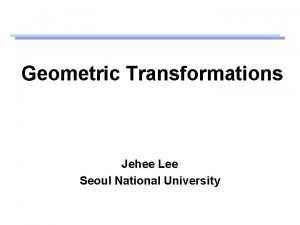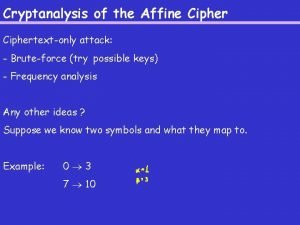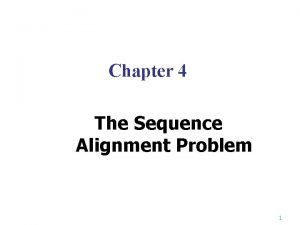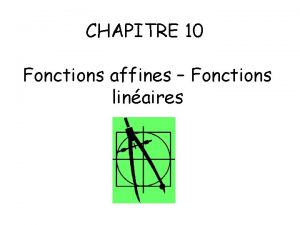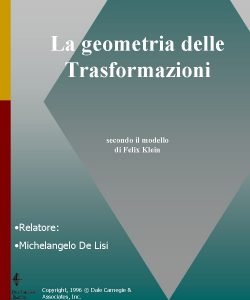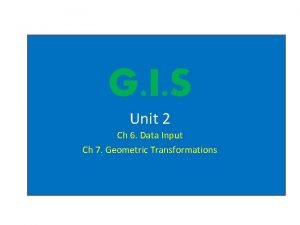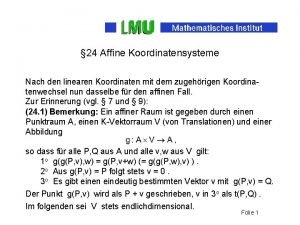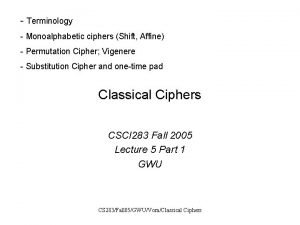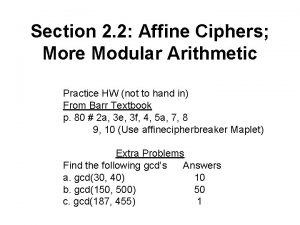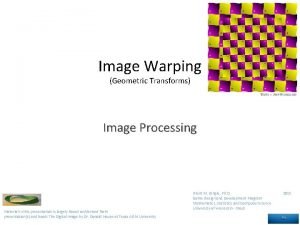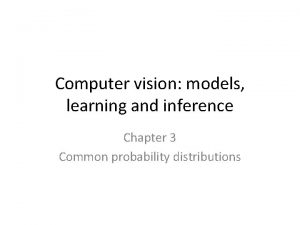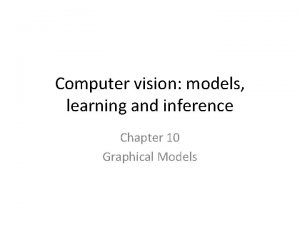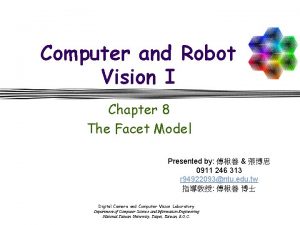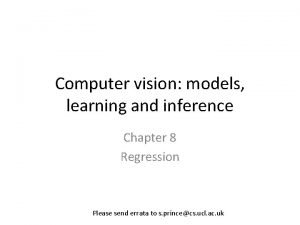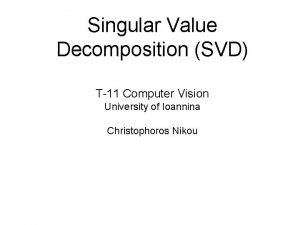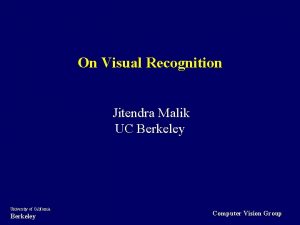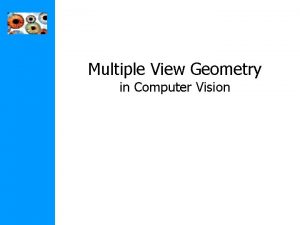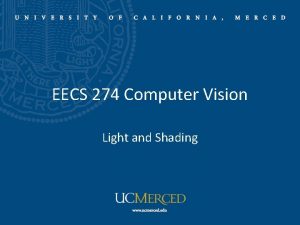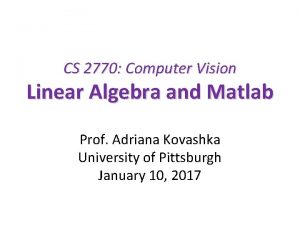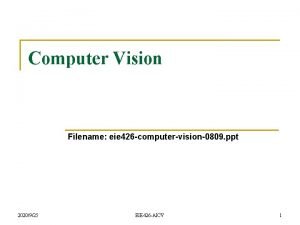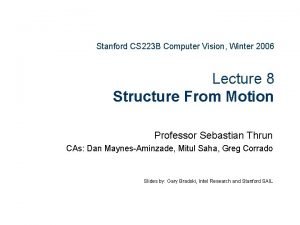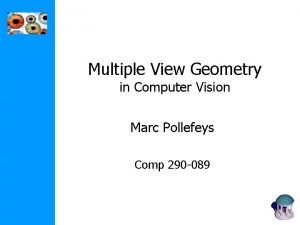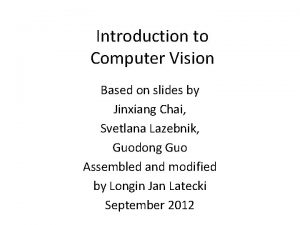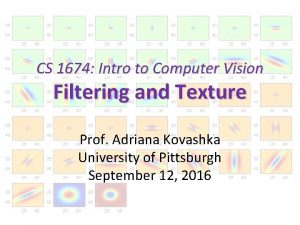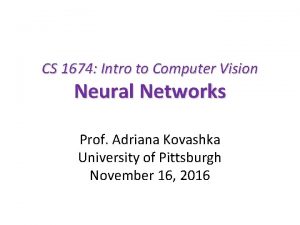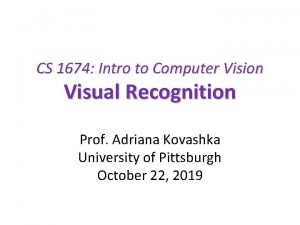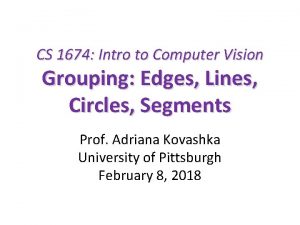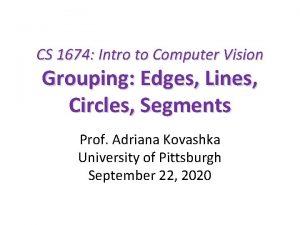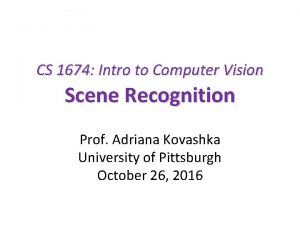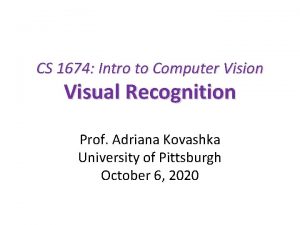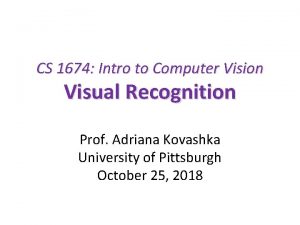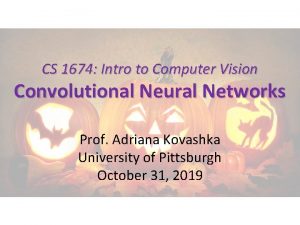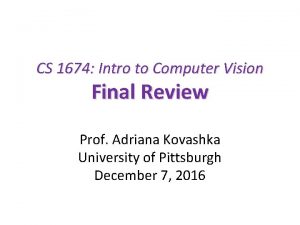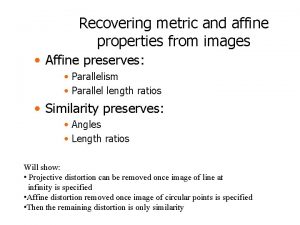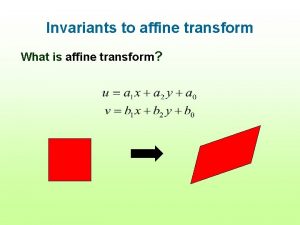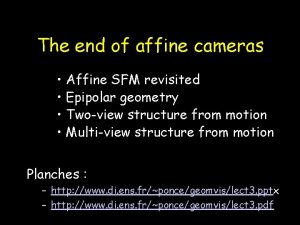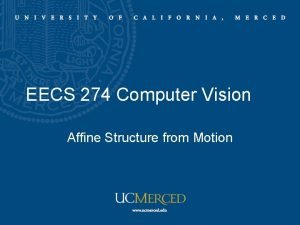CS 1674 Intro to Computer Vision Affine and






































- Slides: 38

CS 1674: Intro to Computer Vision Affine and Projective Transformations Prof. Adriana Kovashka University of Pittsburgh October 3, 2016

Alignment problem • We previously discussed how to match features across images, of the same or different objects • Now let’s focus on the case of “two images of the same object”(e. g. xi and xi’) and examine it in more detail • What transformation relates xi and xi’? • In alignment, we will fit the parameters of some transformation according to a set of matching feature pairs (“correspondences”). xi xi' T Adapted from Kristen Grauman and Derek Hoiem

Two questions T T Kristen Grauman Alignment: Given two images, what is the transformation between them? Warping: Given a source image and a transformation, what does the transformed output look like?

Motivation for feature-based alignment: Image mosaics Kristen Grauman Image from http: //graphics. cmu. edu/courses/15 -463/2010_fall/

What are the correspondences? Min SSD = match ? • Compare content in local patches, find best matches. Simplest approach: Scan xi’ with template formed from a point in xi, and compute Euclidean distance (a. k. a. SSD) or normalized crosscorrelation between list of pixel intensities in the patch. Kristen Grauman

What are the transformations? Examples of transformations: affine Alyosha Efros aspect rotation translation perspective

Parametric (global) warping T p = (x, y) p’ = (x’, y’) Transformation T is a coordinate-changing machine: p’ = T(p) What does it mean that T is global? • It is the same for any point p • It can be described by just a few numbers (parameters) Let’s represent T as a matrix: p’ = Mp Alyosha Efros

Scaling a coordinate means multiplying each of its components by a scalar Uniform scaling means this scalar is the same for all components: 2 Alyosha Efros

Scaling Non-uniform scaling: different scalars per component: X 2, Y 0. 5 Alyosha Efros

Scaling operation: Or, in matrix form: scaling matrix S Alyosha Efros

2 D Linear Transformations Only linear 2 D transformations can be represented with a 2 x 2 matrix. Linear transformations are combinations of … • Scale, • Rotation, • Shear, and • Mirror Alyosha Efros

What transforms can we write with a 2 x 2 matrix? 2 D Scaling? 2 D Rotate around (0, 0)? 2 D Shear? Modified from Alyosha Efros Fig. from https: //www. siggraph. org/education/materials/Hyper. Graph/modeling/mod_tran/2 dshear. htm

What transforms can we write with a 2 x 2 matrix? 2 D Mirror about Y axis? 2 D Mirror over (0, 0)? 2 D Translation? CAN’T DO! Alyosha Efros

Homogeneous coordinates To convert to homogeneous coordinates: homogeneous image coordinates Converting from homogeneous coordinates Kristen Grauman

Translation Homogeneous Coordinates tx = 2 ty = 1 Alyosha Efros

2 D Affine Transformations Affine transformations are combinations of … • Linear transformations, and • Translations Maps lines to lines, parallel lines remain parallel Adapted from Alyosha Efros

Fitting an affine transformation • Assuming we know the correspondences, how do we get the transformation? Alyosha Efros

Fitting an affine transformation • How many matches (correspondence pairs) do we need to solve for the transformation parameters? • Once we have solved for the parameters, how do we compute given ? • Where do the matches come from? Modified from Kristen Grauman

Projective Transformations Projective transformations: • Affine transformations, and • Projective warps Parallel lines do not necessarily remain parallel Kristen Grauman

Projection: world coord image coord . Optical center . . y’ x’ f' . y z x Camera center x’ ‘’ Scene point Modified from Derek Hoiem and Kristen Grauman y’ ‘’ Image coordinates

Image mosaics: Goals . . . image from S. Seitz Obtain a wider angle view by combining multiple images. Kristen Grauman

Image mosaics: Camera setup Two images with camera rotation/zoom but no translation Adapted from Derek Hoiem Camera Center

Mosaic: Many 2 D views of same 3 D object mosaic plane The mosaic has a natural interpretation in 3 D • The images are reprojected onto a common plane • The mosaic is formed on this plane • Mosaic is a synthetic wide-angle camera Steve Seitz

Image reprojection Basic question • How to relate two images from the same camera center? – how to map a pixel from PP 1 to PP 2 Answer • Cast a ray through each pixel in PP 1 • Draw the pixel where that ray intersects PP 2 Observation: • Alyosha Efros Rather than thinking of this as a 3 D reprojection, think of it as a 2 D image warp from one image to another. PP 1

Projective transforms A projective transform is a mapping between any two PPs with the same center of projection • rectangle should map to arbitrary quadrilateral • parallel lines aren’t • but preserves straight lines Also called Homography PP 2 PP 1 p’ Adapted from Alyosha Efros H p

How to stitch together a panorama (a. k. a. mosaic)? • Basic Procedure – Take a sequence of images from the same position • Rotate the camera about its optical center – Compute the homography (transformation) between second image and first – Transform the second image to overlap with the first – Blend the two together to create a mosaic – (If there are more images, repeat) Modified from Steve Seitz

Computing the homography … … To compute the homography given pairs of corresponding points in the images, we need to set up an equation where the parameters of H are the unknowns… Kristen Grauman

Computing the homography p’ = Hp Can set scale factor i=1. So, there are 8 unknowns. Set up a system of linear equations: Ah = b where vector of unknowns h = [a, b, c, d, e, f, g, h]T Need at least 8 eqs, but the more the better… Solve for h. If overconstrained, solve using least-squares: Kristen Grauman

Computing the homography • Assume we have four matched points: How do we compute homography H? p’=Hp A • Apply SVD: UDVT = A [U, S, V] = svd(A); • h = Vsmallest (column of V corr. to smallest singular value) Derek Hoiem

How to stitch together a panorama (a. k. a. mosaic)? • Basic Procedure – Take a sequence of images from the same position • Rotate the camera about its optical center – Compute the homography (transformation) between second image and first – Transform the second image to overlap with the first – Blend the two together to create a mosaic – (If there are more images, repeat) Modified from Steve Seitz

Transforming the second image Image 2 Image 1 canvas To apply a given homography H • Compute p’ = Hp (regular matrix multiply) • Convert p’ from homogeneous to image coordinates Modified from Kristen Grauman p’ H p

Transforming the second image Image 2 Image 1 canvas H(x, y) y’ y x f(x, y) x’ g(x’, y’) Forward warping: Send each pixel f(x, y) to its corresponding location (x’, y’) = H(x, y) in the right image Modified from Alyosha Efros

Transforming the second image H(x, y) y’ y x f(x, y) x’ g(x’, y’) Forward warping: Send each pixel f(x, y) to its corresponding location (x’, y’) = H(x, y) in the right image Q: what if pixel lands “between” two pixels? A: distribute color among neighboring pixels (x’, y’) Alyosha Efros

Transforming the second image Image 2 Image 1 canvas H-1(x, y) y’ y x f(x, y) x’ g(x’, y’) Inverse warping: Get each pixel g(x’, y’) from its corresponding location (x, y) = H-1(x’, y’) in the left image Modified from Alyosha Efros

Transforming the second image H-1(x, y) y’ y x f(x, y) x’ g(x’, y’) Inverse warping: Get each pixel g(x’, y’) from its corresponding location (x, y) = H-1(x’, y’) in the left image Q: what if pixel comes from “between” two pixels? A: interpolate color value from neighbors Alyosha Efros >> help interp 2

Homography example: Image rectification p p’ To unwarp (rectify) an image solve for homography H given p and p’: p’=Hp Derek Hoiem

Summary • Write 2 d transformations as matrix-vector multiplication (including translation when we use homogeneous coordinates) • Projection equations express how world points mapped to 2 d image. • Fitting transformations: solve for unknown parameters given corresponding points from two views – linear, affine, projective (homography) • Mosaics: uses homography and image warping to merge views taken from same center of projection • Perform image warping (forward, inverse) Adapted from Kristen Grauman

The next 15 hidden slides give some more detail about how image formation works, i. e. how 3 D objects are mapped to 2 D images. Please review on your own time if you’re interested.
 1674 microscopy
1674 microscopy Human vision vs computer vision
Human vision vs computer vision Affine transformation examples
Affine transformation examples Affine gap
Affine gap Affine cipher brute force
Affine cipher brute force Affine gap distance
Affine gap distance Prix des linaires
Prix des linaires Affine cipher
Affine cipher Warp affine
Warp affine Omologia affine ortogonale
Omologia affine ortogonale Equiarea
Equiarea Exemple de fonction dans la vie courante
Exemple de fonction dans la vie courante Affine koordinatensysteme
Affine koordinatensysteme Permutation cipher
Permutation cipher 285 mod 26
285 mod 26 Nutzwertanalyse
Nutzwertanalyse Morse code alphabet
Morse code alphabet Affine image warping
Affine image warping Computer vision
Computer vision Mathematical foundations of computer graphics and vision
Mathematical foundations of computer graphics and vision Computer vision: models, learning, and inference
Computer vision: models, learning, and inference Computer vision models learning and inference pdf
Computer vision models learning and inference pdf Computer and robot vision
Computer and robot vision Computer vision: models, learning, and inference
Computer vision: models, learning, and inference 16-385 computer vision
16-385 computer vision Kalman filter computer vision
Kalman filter computer vision T11 computer
T11 computer Berkeley computer vision
Berkeley computer vision Multiple view geometry in computer vision
Multiple view geometry in computer vision Font detector
Font detector Radiometry in computer vision
Radiometry in computer vision Linear algebra for computer vision
Linear algebra for computer vision Computer vision
Computer vision Computer vision ppt
Computer vision ppt Cs223 stanford
Cs223 stanford Multiple view geometry in computer vision
Multiple view geometry in computer vision Azure cognitive services python
Azure cognitive services python Computer vision slides
Computer vision slides Ilsvrc 2012
Ilsvrc 2012


